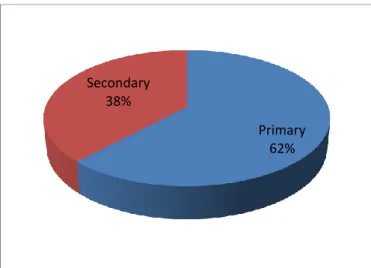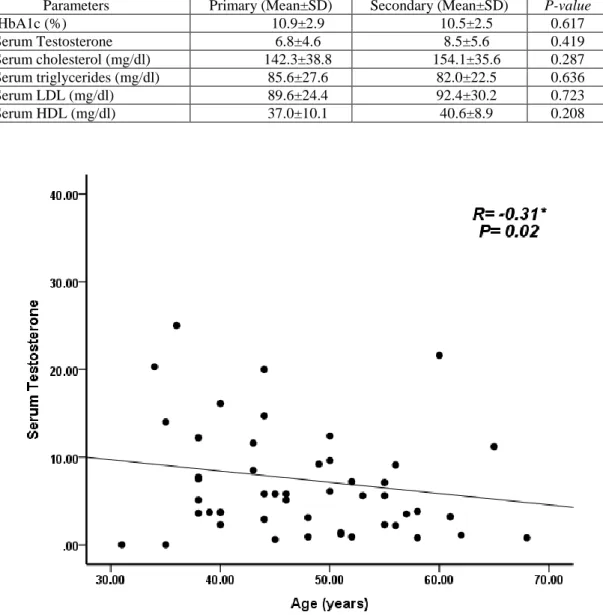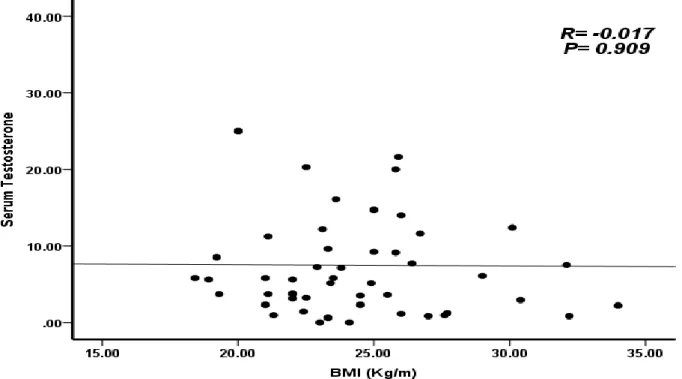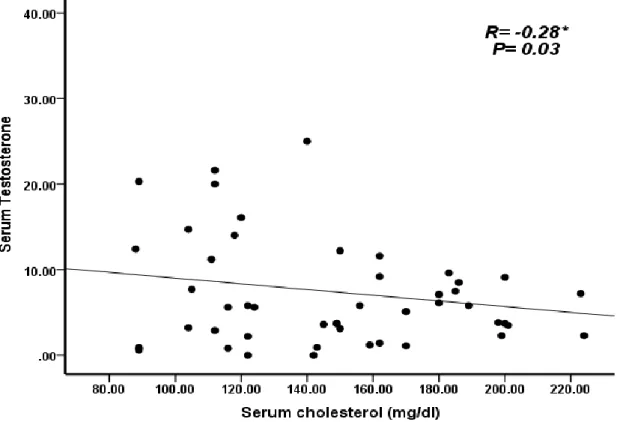Daralnaem S. E. Adam et al JMSCR Volume 06 Issue 09 September 2018 Page 508
Evaluation 0f testosterone level in infertile Sudanese male with type 2
diabetic and its relation with lipid profile
Authors
Daralnaem S. E. Adam, Abdelmula M. Abdalla
1*
1
Department of Clinical Chemistry, Faculty of Medical Laboratory Science, Al Neelain University, Khartoum, Sudan
Abstract
Background: Diabetes mellitus (DM) is increasing in men of reproductive age, and the number of diabetic men attending fertility clinics is largely increased. Testosterone is the male sex hormone, and plays a vital role in glucose homeostasis, lipid metabolism, and semen parameters.
Objectives: The aim of this study to assess serum total Testosterone levels among in infertile Sudanese males with type 2 diabetes mellitus and its relation to lipid profile and comparison with apparently healthy control.
Materials and Methods: A case-control study was conducted on 50 non-diabetic control group and 50 infertile diabetic men test group with age range (30-70 years). The analyzed variables age, BMI, serum levels of total Testosterone, HA1c,lipid profile ,and semen parameters were measured.
Results: Serum Total Testosterone levels were significantly lower in infertile male with type diabetes when compared with control group (7.45 ± 1.07 versus 22.21 ± 3.1, p<0.000) .Where as serum HbA1c (%), triglyceride, and LDL were significantly increased (10.73±1.72 versus 4.96±0.72, 102.4±12.5 versus 81.11±6.43 , 96.68±8.43 versus 84.39±6.65, p < 0.01 respectively). In addition the study observed no significant difference in cholesrterol and HDL levels ( p > 0.05 ) in the test group when compared with their control .In comparing the results of patients with primary infertility with that with secondary infertility in the test group there is no significant difference in all measured variables (p > 0.05) . In addition serum testosterone level is significantly inversely correlated with age (r =- 0.31, p = 0.02), HbA1c (%) (r = -0.30. p = 0.02), total cholesterol (r = - 0.28. p = 0.03), and LDL (r = -0.26. P = 0.04), and insignificantly correlated with BMI, triglyceride, and HDL (p > 0.05). The testosterone level in the diabetic infertile test group illustrated significant inverse correlation with number of sperm with abnormal morphology (r= - 0.34, p= 0.01), and insignificantly correlated with sperm count , motility and semen volume (P > 0.05) as in table 3.
Conclusion: It concluded that, type 2 diabetes mellitus significantly altered serum total testosterone level in infertile male, which is inversely correlated with dyslipidemia and semen quality.
Keywords: Glysemic control, type 2 diabetes, serum total testosterone, Lipid profile, HbA1c, semen quality.
Introduction
Diabetes mellitus is an endocrine disorders, characterized by hyperglycemia, polyuria, polydepsia and polyphagia, and affects many
organs and is a major causes of renal failure.[1], lower limb amputation for non-traumatic cause, and blindness in adults and with its rate appears to be increasing through the world becoming the
www.jmscr.igmpublication.org Impact Factor (SJIF): 6.379
Index Copernicus Value: 79.54 ISSN (e)-2347-176x ISSN (p) 2455-0450
Daralnaem S. E. Adam et al JMSCR Volume 06 Issue 09 September 2018 Page 509 most frequent causes of death.[1,2] . Sex derive and
desire are regulated by sex hormones which are affected by psychological factors and metabolic disorders such as diabetes mellitus. Testosterone is the male sex hormone, is essential for many vital processes in the body.[1,2,3]. Lack of testosterone affects the male fertility and cause a decrease in libido, impotency, decrease in muscle mass, fatigue, decrease in bone density and osteoporosis. An inverse relationship exists between testosterone levels and insulin concentrations in healthy men, Biochemical evidence indicates that testosterone is involved in promoting glucose utilization by stimulating glucose uptake, glycolysis.[2,3,4] , and lipolysis. There has been an alarming increase, of epidemic proportions, in both obesity and diabetes in the general population with increased cardiovascular risk associated with type 2 diabetes mellitus (T2DM).[3,5]
Many researchers have demonstrated that the level of testosterone in type 2 diabetes mellitus is lower than normal subject. This observation is also true for the free testosterone level.[3,4] ,Some other studies did not observe such relation [5,6]. There is few and inconsistencies studies concerning the effect of diabetes mellitus on semen parameters, and rarely focused on this disorder in the infertile patients. Modern researches illustrated that diabetes mellitus causes subtle molecular abnormalities that are essential for sperm function and quality. DM changes conventional sperm parameters. In addition, DM results in histologic damage of the epididymis, with a negative effect on sperm transit. Many mechanisms explain the sperm damage in diabetic patients. These include oxidative stress, endocrine diseases, and neuropathy.[7,8]. Because the diabetes is a common disease and considering the importance and the role of testosterone it would be worthful to investigate the factors that can cause a decrease in testosterone level in infertile Sudanese males with type 2 diabetes mellitus and its relation to serum lipid profile
Materials and Methods
Current study was a case-control study, was conducted in diabetic clinic –Khartoum-Sudan. In this study100 men aged 30-70 years, including 50 diabetic infertile patients and 50 non diabetic. Weight was measured to the nearest 100 grams using a digital personal scale. Height was measured using a tape meter, to the nearest centimeter, in standing position without shoes. Body mass index (BMI) was calculated by taking a person's weight (Kg) dividing by their height (meter) squared. BMI=Weight/Height (Kg/m) All the male participants with a BMI between 20 and 40 having other inclusion criteria were included in the study.
Inclusion Criteria: any infertile male patients who have Diabetes type 2.
Exclusion Criteria: fertile Sudanese male with type2 diabetic A known history of hypogonadism, panhypopituitarism, or chronic debilitating disease such as renal failure, cirrhosis and dyslipidemia were excluded from our study or those who were on testosterone supplementation were excluded from the study’s.
Data Collection and Clinical Examination
On the same fasting blood samples obtained for the case control study and follow-up studies, glycosylated hemoglobin (HbA1c), cholesterol triglycerides, and total and high -density lipoprotein (HDL) and low density lipoprotein (LDL), were measured using standard methodologies in the laboratory of the diabetic clinic-Khartoum -Sudan.
Sample Collection
Blood was taken from each participant by standard procedures, serum for total testosterone, total cholesterol, triglyceride, HDL, and blood container contain EDTA anticoagulant for HbA1c estimation.
Daralnaem S. E. Adam et al JMSCR Volume 06 Issue 09 September 2018 Page 510 (WHO, 1999). Sperm morphology was assessed
according to Tygerberg Strict Criteria (Kruger et al., 1988 ). Semen analysis was performed within 1 h of ejaculation, following a period of incubation at 37°C to allow for liquefaction.
Ethical Considerations
Informed consent was taken from all participants and ethical approval was obtained from EL-Neelain University Research Committee.:
Estimation of testosterone level
Serum total testosterone was measured using ELIZA method.
Estimation of glycosylated hemoglobin (HbA1c)
HbA1C was determined by ion exchange chromatography (DS5, Drue Company). Based on American Diabetes Association glycemic control was defined when HbA1C < 7 percent was achieved.
Estimation of lipid profile
Total cholesterol, triglycerides, HDL were measured by spectrophotometry,
Quality control
Samples representing the normal and pathological level of all measured parameters were used for assessment of the quality control .Results ±2SD of the target values of the control sera were accepted.
2.10 Statistical analysis
Data was analyzed by computer software, by using SPSS program manual Master sheet (SPSS version 17). The means and standard deviations of all measured parameters were obtained, and the T- test was used for the comparison between the test and control group, and the mean difference is significant at p ≤ 0.05, Correlation(r) between all measured parameters is considered to be statistically significant at P ≤ 0.05.
Results
The samples of this study were 100 men between 30 and 70 years including 50 infertile diabetic test group and 50 non-diabetic healthy men control group sex and age matched shown in table 1, 62% of the test group with primary infertility where as secondary infertility comprised 38 % of the test group in figure 1.mean age and BMI did not show
any significant difference between diabetic and non-diabetic groups in table 1 .
The serum Total Testosterone levels were significantly lower in infertile male with type2 diabetes as compared to control group ( 7.45 ± 1.07 versus 22.21 ± 3.1, p<0.000) .Where as serum HbA1c (%), triglyceride, and LDL were significantly increased (10.73±1.72 versus 4.96±0.72, 102.4±12.5 versus 81.11±6.43, 96.68±8.43 versus 84.39±6.65, p <0.01 respectively), and no significant difference in cholesterol and HDL level (146.74±7.69 versus 144.54±6.71, 38.35±4.71versus37.17±5.69, p > 0.05 respectively) as shown in table 1.In comparing the results of patients with primary infertility with that with secondary infertility in the test group there is no significant difference in all measured variables (p > 0.05) in table 2. In the test group serum testosterone level is significantly inversely correlated with age (r =- 0.31, p = 0.02), HbA1c (%) ( R = -0.30. p = 0.02), total cholesterol( r = - 0.28. p = 0.03), and LDL(r = -0.26. P = 0.04) in figures 1,2,3,4, and insignificantly correlated with BMI, triglyceride, and HDL (p > 0.05) in figures 5,6,7
The testosterone level in the diabetic infertile test group shows significant inverse correlation with number of sperm with abnormal morphology (r= - 0.34, p= 0.01), and insignificantly correlated with abnormal sperm count and motility (P > 0.05) as in table 3.
Figure (1) Percentage of Primary and secondary Infertile Sudanese male in the study group
Primary 62% Secondary
Daralnaem S. E. Adam et al JMSCR Volume 06 Issue 09 September 2018 Page 511
Table 1 Comparison of serum total testosterone, HbA1c (%), total cholesterol, triglyceride, LDL, and HDL in the test group with their control group
Parameters Case (Mean±SD) Control (Mean±SD) P-value
HbA1c (%) 10.73±1.72 4.96±0.72 0.000
Serum Testosterone 7.45±1.07 25.22±6.70 0.000
Serum cholesterol (mg/dl) 146.74±7.69 144.54±6.71 0.768
Serum triglycerides (mg/dl) 102.4±12.5 81.11±6.43 0.004
Serum LDL (mg/dl) 96.68±8.438 84.39±6.65 0.006
Serum HDL (mg/dl) 38.35±4.71 37.17±5.69 0.668
BMI (Kg/m) 24.39±3.49 25.27±4.35 0.543
Table 2 Comparison of serum total testosterone, HbA1c (%), total cholesterol, triglyceride, LDL, and HDL between diabetic patients with primary and secondary infertility in the test group
Parameters Primary (Mean±SD) Secondary (Mean±SD) P-value
HbA1c (%) 10.9±2.9 10.5±2.5 0.617
Serum Testosterone 6.8±4.6 8.5±5.6 0.419
Serum cholesterol (mg/dl) 142.3±38.8 154.1±35.6 0.287
Serum triglycerides (mg/dl) 85.6±27.6 82.0±22.5 0.636
Serum LDL (mg/dl) 89.6±24.4 92.4±30.2 0.723
Serum HDL (mg/dl) 37.0±10.1 40.6±8.9 0.208
Daralnaem S. E. Adam et al JMSCR Volume 06 Issue 09 September 2018 Page 512
Figure 3 Ascotter plot shows the relationship between serum total Testosterone (ng/ml) and BMI (Kg/m)
Daralnaem S. E. Adam et al JMSCR Volume 06 Issue 09 September 2018 Page 513
Figure 5 Ascotter plot shows the relationship between serum total Testosterone (ng/ml) and serum cholesterol (mg/dl)
Figure 6 Ascotter plot shows the relationship between serum total Testosterone (ng/ml) and serum Triglyceride (mg/dl).
Daralnaem S. E. Adam et al JMSCR Volume 06 Issue 09 September 2018 Page 514
Figure 7 Ascotter plot shows the relationship between serum total Testosterone (ng/ml) and serum total LDL cholesterol (mg/dl)
Figure 8 Ascotter plot shows the relationship between serum total Testosterone (ng/ml) and serum total HDL cholesterol (mg/dl)
Table 4 Correlation of serum testosterone level with sperm count, morphology, motility and semen volume in the study group
Parameter Statistic Motility count Abnormal morphology Semen volume
Testosterone Person correlation 0.14 0.17 0.29 0.19
significance 1.3 1.05 0.01 0.6
Daralnaem S. E. Adam et al JMSCR Volume 06 Issue 09 September 2018 Page 515
Discussion
Diabetes mellitus is endocrine disease that causes long term damage to many organs including the reproductive system. Testosterone is male hormone that play a vital role in glucose, lipid metabolism and sperm quality[1,3)
Many studies have illustrated the relationship between increased BMI and serum testosterone level in patients with T2DM. The results of these studies are inconsistence. Some studies observed a significant correlation between BMI and serum total testosterone level[9,10]. In contrast, other studies demonstrated insignificant correlation between total testosterone and BMI.[11] However, our study recorded insignificant correlation between BMI and serum total testosterone levels. In the current study serum total testosterone is significantly lower in the infertile patients with type 2 diabetes mellitus compared to healthy subjects. This finding is consistence with studies performed by Jihan MM et al (2016)[12], Tajar et al (2010) [13],, and Dhindsa et al(2004)[14], they demonstrated significant number of men with type 2 diabetes have low testosterone level.Many cross sectional studies and systemic analyses illustrated that T2DM is associated with low serum Total Testosterone level. Al hayek et al in (2013) [15], found that 36.5% of patients with diabetes had low serum testosterone level, Kapoor et al in (2007) [16], found that 20% (71 men) had low total Testosterone level. Type 2 diabetes mellitus is high risk factor affecting male reproductive function, and affect the testosterone production and metabolism[17], causing alteration in testosterone level. Testosterone production could be inhibited by the functional alterations in the Leydig cell either directly through the testis or through changes along the hypothalamus pituitary and testicular axis. The major transporter of sex steroids sex hormone binding globulin could interfere in the bioavailability of this male hormone. To date the exact mechanism by which type 2 diabetes inhibits testosterone biosynthesis is obscure-[18]. Leydig cell testosterone biosynthesis is primarily regulated by pulsatile
secretion of luteinizing hormone (LH)[19]. In addition reduced levels of testosterone in infertile patients with type 2DM may be related to diabetic create - oxidative stress that causing a significant decrease in testicular and adrenal androgen synthesis[20]. Furthermore Yen et al, in their study obsrearved that metabolic alterations caused by type 2DM attenuated the chemical responsiveness of testicular Leydig cells and impair the secretions of testosterone [21].
In the present study testosterone level in the infertile test group with type 2 DM is significantly inversely correlated with age .which disagree with Dhindsa et al (2004)[14]. and Agbecha et al (2017)[22]. The significant negative correlation recorded between testoster-one and age in our infertile diabetic patients clearify the physiological role of advanced age on testosterone reduction. Observational studies consistently show that men with type 2 diabetes independent of age and obesity have lowered circulating testosterone levels[23,24]. More over in a prospective study, the metabolic syndrome is observed to predict low serum testosterone level.[25].
Important finding In the present study, testosterone level in the infertile test group with type 2 DM is significantly negatively correlated with HbA1c (%).which collaborated with Nagla et al (2018)[26]. Whom reflect the significant relationship that exist between the good glycemic control (based on HbA1C≤7) and serum testosterone level Uncontrolled hyperglycemia induced low testosterone level. Systemic review concluded that poor glycemic control in type 2 DM is associated with low serm testosterone level. Many authors reported that locally circulating hormones, growth hormone, and cytokines affect Leydig cell steroidogenesis) [19]. [2]
Daralnaem S. E. Adam et al JMSCR Volume 06 Issue 09 September 2018 Page 516 at one or more functional levels of the
hypothalamus-pitutary- testis axis. However it is obscure how the axis of hypothalamus-pitutary- testis forms the relationship between insulin and testosterone level) [19] .
In the present study testosterone level in the infertile test group with type 2 DM is significantly inversely correlated with triglyceride, total cholesterol, and LDL
Which is consistent with Nirmali et al (2015) [27] and Samathia et al (2012)[28].Whom deduced negative association of total testosterone level with cardiac risk factors in patients with type 2 DM. Some evidence from epidemiological study deduce that total testosterone level is correlated inversely with total cholesterol, LDL- cholesterol, and triglyceride, and positively with HDL- cholesterol. In addition trail of testosterone replacement therapy have illustrated improvement of lipid profile in dyslipidemic subjects. But the mechanism through which testosterone interfere in lipid profile is obscure. Furthermore, recently some researchers suggested that low testosterone can be considered as new cardiovascular risk factor in adult[29].
In the present study Sperm concentration and motility is reduced in infertile test group with type 2 DM, and serum testosterone level is significantly inversely correlated with number of sperm with abnormal morphology. In accordance with Delfino et al (2007)[30], whom observed significant changes in sperm morphology in type 2 diabetic patients .Jing et al (2017)[31] conducted systemic review and meta-analysis to assess the effect of DM on semen parameter and concluded that DM had negative effect on the quality of the semen. Growing evidence explore that DM affect the male fertility through its adverse effect on male reproductive function in multiple level. The disruption of the spermatogenic process, and the apoptosis of the germ cell in DM are considered to be linked to local autoimmune damage[32]. Insulin stimulate many of the lydig cell functions that can affect the spermatogenesis outcome [33]
Conclusion
Type 2 diabetes mellitus causes low total testosterone level, that affects the cardiovascular risk factors and semen parameters.
Consent
As per international standard or university Standard, patient’s written consent has been collected and preserved by the authors..
Ethical Approval
As per international standard or university standard, written approval of Ethics committee has been collected and preserved by the authors.
Competing Interests
Authors have declared that no competing interests exist.
Authors’ contribution
This work was carried out in collaboration between all authors. Author DSEA designed the study, performed the statistical analysis, wrote the protocol and wrote the first draft of the manuscript.
Authors (DSEA) and AMA managed the analyses of the study and the literature searches. All authors read and approved the final manuscript.
Acknowledgements
The authors gratefully acknowledge the diabetes patients at Reproductive Health Care Center and Jafar ibn Auf Hospital in Khartoum state, Sudan, for their assistance with obtaining the data used in this study
References
1. Power A. Diabetes Melitus. In: Fauci AS, Braun wald E, Kasper DS, Hauser SL, Lango DL, Jameson JL, et al., editors. Harrisons Internal Medicine 17nd edition. New York: McGrawHill Inc; 2008. p. 2275-7.:
2. Kelly D, Jones T. Testosterone a metabolic hormone in health and disease. Journal of Endocrinology, 2013; 217: 25–45.
Daralnaem S. E. Adam et al JMSCR Volume 06 Issue 09 September 2018 Page 517 review and meta-analysis. JAMA., 2006;
295(11): 1288-99.
4. Al Hayek AA, Khader YS, Jafal S, Khawaja N, Robert AA, Ajlouni K. Prevalence of low testosterone levels in men with type 2 diabetes mellitus: a cross-sectional study. J Fam Community Med., 2013; 20: 179-86.
5. Kapoor D, Aldred H, Clark S, Channer KS & Jones TH. AClinical and biochemical assessment of hypogonadism in men with type 2 diabetes: correlations with bio-available testosterone and visceral adiposity. Diabetes Care. 2007; 30: 911– 17.
6. Rhoden. E. L, Ribeiro. E. P, Teloken. C, Souto. C. A.V. Diabetes mellitus is associated with subnormal serum levels of free testosterone in men. BJU International., 2005; 96(6): 867–70.
7. Ari Kawe, A,p.,A. Daramola, A. Odofin, L, Obika, Alloxan-induced and insulin-resistant diabetes mellitus affect semen parameters and impair spermatogenesis in male rates. Afr. J.Reprod. Health.,10(3), 2006,106-113.
8. Wang, Y.,Z.Zhang,w, G Guo, W.Sun, X.Miao, H.w u,L.Cai, Sulforaphane reduction of testicular apopotic cell death in diabetic mice is associated with the upregulation of Nrf2 expression and function. Am. J. physiol, Endocrinol. metab.307(1),2014,E 14-23.
9. Aftab SA, Kumar S, Barber TM. The role of obesity and type 2 diabetes mellitus in the development of male obesity-associated secondary hypogonadism. Clin Endocrinol (Oxf)., 2013; 78:330-7.
10.Shota Janjgava, et.al, Influence of testosterone replacement therapy on metabolic disorders in male patients with type 2 diabetes mellitus and androgen deficiency , European Journal of Medical Research., 2014, 19: 56.
11.Kitty Kit Ting Cheung, et.al. Testosterone level in men with type 2 diabetes mellitus and related metabolic effects: A review of current evidence, J Diabetes Invest., 2015; 6: 112–123.
12.Jihan Mohamed Mohiedin,Noon Babiker, Omer Mohamed Abdalla.Effect of type 2 Diabetes Mellitus on Sudanese male fertility. Sch. J. App.med.sci, 20016,4 (6E):2216-2223.
13.Tajar A,Forti G,O Neill TW,Lee Dm,Silman Aj, Finn JD et al, characteristic of secondary, primary and compensated hypogonadism in ageing men,evidence from the European male ageing study.J clin Endocrinol metab.2010,05(4):1810-8 14.Dhindsa S, Prabhakar S, Sethi M,
Bandyopadhyay A, Chaudhuri A, Dandona P. Frequent occurrence of hypogonad-otropic hypogonadism in type 2 diabetes. J Clin Endocrinol Metab., 2004; 89: 5462– 8.
15.Al Hayek AA, Khader YS, Jafal S, Khawaja N, Robert AA, Ajlouni K. Prevalence of low testosterone levels in men with type 2 diabetes mellitus: a cross-sectional study. J Fam Community Med., 2013; 20: 179-86.
16.Kapoor D, Aldred H, Clark S, Channer KS & Jones TH. AClinical and biochemical assessment of hypogonadism in men with type 2 diabetes: correlations with bioavailable testosterone and visceral adiposity. Diabetes Care., 2007; 30: 911– 17.
17.Rato,L.,M.Alves,T.Dias,,G.LOPES,J.Cava co,S.Socorro,p.Oliveira.High energy diets may induce a pre-diabetic state altering testicular glycolytic metabolic profile and male reproductive parameters-Andrology. (3).2013,495-505
Daralnaem S. E. Adam et al JMSCR Volume 06 Issue 09 September 2018 Page 518 haemoglobin in middle-aged and older
men. Clin Endocrinol (Oxf) 2011;74:572-8.
19.Saez JM. Leydig cells: Endocrine, paracrine, and autocrine regulation. Endocr Rev 1994;15:574-626.
20.Zhao J, Zhai L, Liu Z, Wu S, Xu L. Leptin level and oxidative stress contribute to obesity-induced low testosterone in murine testicular tissue. Oxid Med Cell Longev 2014; 2014: 190945
21.Maggio M, Basaria S. Welcoming low testosterone as a cardiovascular risk factor. InternationalJournal of Impotence Research. 2009; 21: 261–64.
22.Agbecha A, Usoro CA. Serum testosterone and insulin resistance in type 2 male diabetics attending University of Calabar teaching hospital, Nigeria. J Med Soc 2017;31:178-84.
23.Dhindsa S, Miller MG, McWhirter CL, Mager DE, Ghanim H, Chaudhuri A, et al. Testosterone concentrations in diabetic and nondiabetic obese men. Diabetes Care 2010;33:1186-92. .
24.Andersson B, Mårin P, Lissner L, Vermeulen A, Björntorp P. Testosterone concentrations in women and men with NIDDM. Diabetes Care 1994;17:405-11. 25.Laaksonen DE, Niskanen L, Punnonen K,
Nyyssönen K, Tuomainen TP, Valkonen VP, et al. The metabolic syndrome and smoking in relation to hypogonadism in middle-aged men: A prospective cohort study. J Clin Endocrinol Metab 2005;90:712-9.
26.Neagla F, Almilgs,Eman A,Eissa, Emain R,,Amer, Mohamed El-Assal. diabetes mellitus link with hypogonadism in male patients with type 2 diabetes mellitus age 40-50 years.Benha medical journal .2015,32:29-35.
27.Nirmali mattack, Runi Deve, Tridiekutum, Dibyarata Patgiri. The evaluation of serum level of testosterone in type2 diabetic men and its relation with lipid profile .journal of clinical and diagnostic research .2015,vol-9(1);BC04-BC07
28.Samathia P, Venkateswarla M, Slva prabodh V. Lipid profile levels in type 2 diabetes mellitus from the trbal population of Adlabad in Andhra Pradcesh , India, journal of clinical and diagnostic research . 2012;6(4):590.
29.Magglo M, Basarla S. Welcoming low testosterone as a cardiovascular risk factor.International journal of impotence Research .2009;21:261-64
30.Delfino M .Imbrogo N. Elia J, Capogreco E,M azzilli F. Prevalence of diabetes mellitus in male partners of infertile couple, Minerva Urol Nefrol.2007;59:131-135
31.Jing-zhen Zhu,Xing-You Dong,Lia-Lia Liang. Zi-Qian Zhang.Xiao Tan Hu.Long Kun Li.Effects of diabetes mellitus on semen quality in adult men .systemic review and meta- analysis .Int J clin Exp Med 2017.10(8):11290-11303
32.La Vignera S, Condovelli R, Vicaan E, D Agata Rand Calogero AE.Diabetus mellitus and sperm parameters. J androl 2012, 33:145-153




